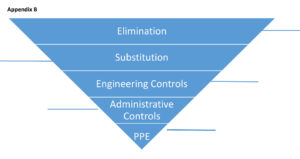- This Discussion Thread has 7 replies, 5 voices, and was last updated 2 months ago by Deborah-S.
-
AuthorPosts
-
-
2024-04-15 at 11:52 pm #12397GraceKeymaster
Reflection activity: Thinking of your current or a past workplace provide specific examples of each hierarchy of control – see Appendix B.

-
2025-10-16 at 12:30 pm #17426Deborah-SMember
Hello.
These are my examples based on long-term care.elimination- discontinuing the use of a chemical that could be a health risk or removing tripping hazards such as throw rugs or furniture in hallways
substitution- replacing the hazard with a safer alternative. example switching latex gloves to nitrile gloves
engineering- isolate people from the hazard. example using needleless IV systems to reduce the risk of needlestick injuries
administrative controls- change the way people work. example would be additional staff training on infection control procedures
PPE- personal protective equipment. example is providing gowns, gloves, googles or visors and masks outside of every room with a resident that has is infectious
-
2025-10-19 at 11:31 am #17469DeborahMember
You provided clear examples of simple safety measures for staff and residents, like removing tripping hazards and using safer gloves, highlighting how small changes can have a big impact.
-
-
2025-10-19 at 11:27 am #17467DeborahMember
Hello,
Hierarchy of Control in LTC home during influenza outbreak:
Elimination – Cancelling group activities and volunteer visits to eliminate exposure opportunities.
Substitution – Conducting MD rounds virtually, with the rest of the healthcare team.
Engineering Controls – Using touch-free door openers and sensors to reduce contamination in high-touch areas.
Administrative Controls – Screening visitors and staff at the front door by a screening aide, including temperature checks and symptom questionnaires.
PPE – Full PPE (masks, gloves, gowns, and face shields) required for staff interacting with symptomatic patients and patients on isolation.-
2025-10-19 at 7:08 pm #17485ShivamMember
Hi Deborah!
You raised great points. I think in a place like a LTC facility, although restricting visitors and stopping all group activities are the best way to stop the transmission and even the entrance of any disease/infection into the LTC, it takes a great toll on the residents. From my experience of working as a PSW during the height of the COVID 19 pandemic, I recall a lot of our residents started to exhibit very unusual behaviours and a rapid cognitive decline who were otherwise very cognitive prior to the isolation measures. We also had a lot of family members of these residents who were not able to see their parents/grandparents during special occasions like Christmas and birthdays and some of the residents even passed away without getting to see their families for over a year.-
2025-10-26 at 3:22 pm #17585Deborah-SMember
I agree with you. I also worked as a PSW during Covid and I did notice a big difference with the residents too. I just don’t see how they could have done anything differently while preventing the spread of Covid. It was so sad to see the residents like that and I noticed that a lot of them were getting depressed. It was such a difficult time with healthcare workers trying to keep everyone safe and the residents feeling isolated from everyone and everything.
-
-
-
2025-10-19 at 2:48 pm #17476KiranjitMember
Elimination: To avoid injuries, unsafe and dangerous equipment was taken out.
Substitution:To prevent allergies, nitrile gloves were used in place of latex gloves.
Engineering controls: Ceiling lifts and negative pressure rooms decreased the danger of infection and harm.
Administrative Controls: Employees complied with safety regulations and received frequent training on infection control.
PPE: The final line of protection consisted of face shields, masks, gloves, and gowns. -
2025-10-19 at 7:00 pm #17484ShivamMember
Good evening!
In my experience working in a LTC facility, I’ve seen how each level of the hierarchy of controls is applied to protect both residents and staff from the COVID 19 virus.
1. Elimination: During COVID-19, elimination was done by restricting visitors and temporarily discontinuing all activities such as pet therapy, Sundays BBQ, Sunday and Wednesday church services, Bingo, sing-alongs, and all other group activities. Having screening staff screen all the incoming staff to prevent the virus from entering the facility in the first place. Staff who showed any symptoms were required to stay home until cleared to return.
2. Substitution: In some cases, we replaced products or procedures with safer alternatives. For example, switching from powdered gloves to non-powdered gloves helped reduce the risk of allergic reactions and respiratory irritation among staff. We also switched from heavy cotton re-usable gowns to much lighter disposable gowns so that the staff could wear the gowns for the whole shift without feeling burnt out due to excessive heat and increased workload.
3. Engineering Controls: Engineering controls included installing physical barriers such as plexiglass at nursing stations, improving ventilation systems, and ensuring that isolation rooms had proper airflow. Automatic hand sanitizer dispensers were also placed at entrances, in hallways, outside each residents rooms, and even in the staff break rooms to encourage frequent use.
4. Administrative Controls: The facility implemented clear IPAC policies, staff training on PPE use, routine audits, and cohorting residents during outbreaks. Schedules were adjusted to minimize staff movement between units, reducing cross-contamination risks.
5. Personal Protective Equipment (PPE): As the last line of defence, we used PPE such as masks, face shields, goggles, gloves, and gowns. Proper donning and doffing procedures were emphasized during training to ensure maximum protection for both residents and staff.
-
-
AuthorPosts
- You must be logged in to reply to this Discussion Thread.